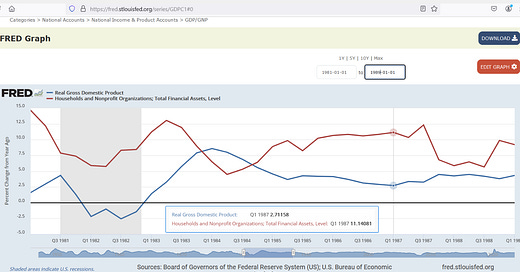There is a saying that a carpenter with a hammer sees every problem as a nail. All of the building up of skill in terms of hammering nails has created a type of bias in the carpenter, a “professionalist” mindset. The carpenter has regretfully lost his ability to be objective when examining certain facts. He let “professionalism” get the best of him.
The very same thing happens to central bankers, people who sit or sat on the Federal Reserve board. They lose an ability to think objectively. Like The Ghostbusters who flinched at every creak heard in a house — by thinking it must be a ghost or a hobgoblin — central bankers do not properly estimate the reality around them.
It’s because the central bankers have stepped into an elite bubble of people who all really do believe that they have attained the power to eliminate hobgoblins. A case-in-point is former central banker, Frederic Mishkin, who, in an End the Fed debate, said this about Black Monday during October 1987 (market fell by over 20% in a single day):
“It was the scariest time that I've ever experienced as an economist."
[at the link above, scroll to the bottom for the video of the debate, where Mishkin makes the remarks during Minute 30 of the debate]
But does Mishkin “have a right” to be so scared of Black Monday? Were hobgoblins around the corner? We all agree that the floor was creaking at the time, but floors do that. Mishkin does not think that the Fed was the cause of Black Monday, only the savior who swooped in and saved the economy of America. But let’s check the numbers:
[click to enlarge]
The blue line is the yearly change in real GDP and the time point marked is the first quarter of 1987 (Black Monday happened in the fourth quarter of 1987). The red line is the yearly change in the value of all financial assets held by households. When the Fed overprints money, those assets inflate. Look at how the gap had been widening.
The value of financial assets held was rising by 11.1% per year in the first quarter of 1987, but the real GDP was only rising by 2.7% a year. When financials rise over 4 times faster than real things do, then get ready for a bubble to pop. Who did that?
The Fed did that.
Mishkin cannot see it, though, because he has succumbed to a “central banker mentality.” Also notice how real GDP growth inched upward through the Black Monday crisis, rather than dipping down — like Mishkin’s fear would have suggested. Looking at real output, there never was a problem. There was only a ghost of one.
But worse is that the Fed created that ghost which they got scared of. They had agreed to depreciate the U.S. dollar in order to fix the trade imbalance with other nations. But after reaching their target, they had created instability. How much of an unstable financial situation?
This much of an unstable financial situation:
[click to enlarge]
Don’t bother rubbing your eyes. What you see is real. It really was the case that the supply of immediately-spendable cash was growing by 11.2% per year when prices only rose by 1.2% per year. The money supply was growing over 9 times faster than the prices were. It doesn’t take a rocket scientist to predict:
That type of thing cannot last.
A likely explanation is that newly-printed money had been hitting the stock market and the market for foreign currency exchange but not as much money was matriculating back — or not coming back as fast — into the goods and services markets. It’s like air destined to be put into a ballon, but which has not gone in yet.
The prices jumped up by a few percent pretty quickly after that, and the interest rate jumped up a few percent also, as the Fed had stopped the depreciation. That caused a scare, but let’s not kid ourselves: The Fed was like a firefighter who, in order to impress others, deliberately started a fire in order to be the hero who puts it out.
A side-issue which gets the official blame for Black Monday is program trading, where a computer model makes the decision to buy or sell, rather than a human being. Human beings could have pulled up the 4 data series above, noting the trend in the things that I noted (growing gap between reals and financials, and between cash and prices).
But that would mean the real humans would have to go ahead and recognize how having a central bank led us into more financial instability. This is a problem, because the justification of central banks is that they are supposed to cause stability. We should not continue to condone having a central bank in the United States.
Reference
[central banker spooks himself; during Minute 30 at video at bottom of page] — https://reason.com/2024/11/14/abolish-the-fed/
[real GDP] — U.S. Bureau of Economic Analysis, Real Gross Domestic Product [GDPC1], retrieved from FRED, Federal Reserve Bank of St. Louis; https://fred.stlouisfed.org/series/GDPC1
[financial assets] — Board of Governors of the Federal Reserve System (US), Households and Nonprofit Organizations; Total Financial Assets, Level [TFAABSHNO], retrieved from FRED, Federal Reserve Bank of St. Louis; https://fred.stlouisfed.org/series/TFAABSHNO
[immediately-spendable cash] — Board of Governors of the Federal Reserve System (US), Currency Component of M1 Plus Demand Deposits (DISCONTINUED) [CURRDD], retrieved from FRED, Federal Reserve Bank of St. Louis; https://fred.stlouisfed.org/series/CURRDD
[price index] — U.S. Bureau of Labor Statistics, Consumer Price Index for All Urban Consumers: All Items in U.S. City Average [CPIAUCSL], retrieved from FRED, Federal Reserve Bank of St. Louis; https://fred.stlouisfed.org/series/CPIAUCSL





